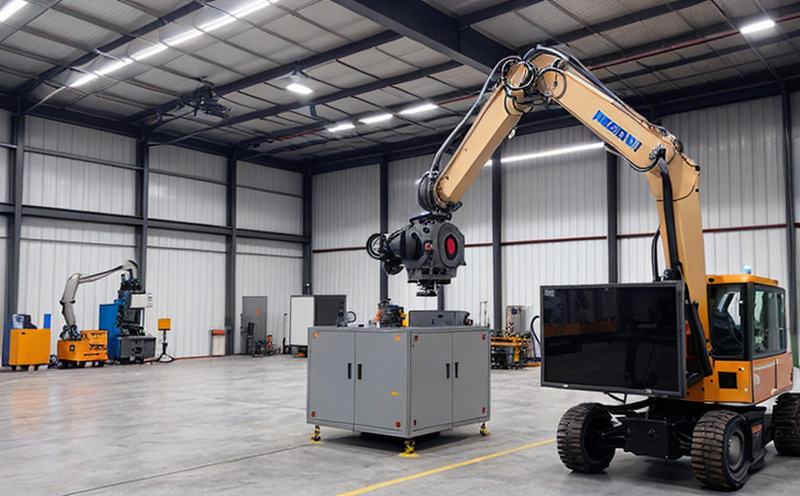ASTM F3459 Servo Response Testing in Industrial Robots
The ASTM F3459 standard provides a framework to evaluate and validate servo response in industrial robots. This testing is crucial for ensuring the precision, repeatability, and reliability of robotic systems within manufacturing environments. The primary focus is on the servo motors that control the movement and positioning accuracy of industrial robots.
The servo system in an industrial robot is responsible for translating electrical signals into mechanical motion with high speed and accuracy. ASTM F3459 aims to assess how well these servos can respond under various conditions, ensuring they meet stringent performance requirements set forth by industry standards. This testing ensures that robotic systems operate safely and efficiently, which is particularly important in sectors such as automotive manufacturing, electronics assembly, and aerospace.
One key aspect of ASTM F3459 testing involves evaluating the servo's ability to follow a commanded trajectory accurately. This includes assessing the time it takes for the robot to reach a target position (settling time), its overshoot or undershoot relative to the desired path, and how quickly it returns to stability after disturbances. The test protocol typically requires simulating real-world working conditions through controlled changes in speed, load, and environmental factors like temperature and humidity.
Another critical component of ASTM F3459 testing is the evaluation of hysteresis and backlash. Hysteresis refers to the difference between forward and reverse movement when passing through a point, while backlash represents any unwanted play or gap in mechanical components that could affect precision over time. By quantifying these parameters during servo response tests, manufacturers can identify potential sources of error and implement corrective measures early in the product lifecycle.
For accurate testing according to ASTM F3459, proper specimen preparation is essential. This includes ensuring all relevant parts are clean, lubricated if necessary, and properly aligned before insertion into the test setup. Calibration of test equipment must also adhere strictly to established procedures outlined within the standard itself or referenced supporting documents like ISO standards for measuring precision.
The testing apparatus used under ASTM F3459 can vary depending on specific requirements but generally includes robotic arms capable of executing predefined motions, motion capture systems to record position data accurately, and force measurement tools to determine loads experienced by the servos during operation. Reporting must follow guidelines specified in ASTM F3459 regarding format, content, and submission deadlines.
Industry leaders recognize the importance of robust servo response testing as evidenced by numerous case studies where improved compliance with ASTM F3459 has led to enhanced operational efficiency and reduced downtime for robotic systems across various applications. Compliance with this standard helps companies maintain their competitive edge in an increasingly automated manufacturing landscape.
International Acceptance and Recognition
The ASTM F3459 Servo Response Testing standard has gained significant traction within the robotics and automation industry, being widely adopted by leading manufacturers worldwide. This widespread acceptance underscores its value as a benchmark for ensuring high-quality industrial robot performance.
- European manufacturers adhere to ASTM F3459 when developing products intended for export markets or those subject to European regulations.
- American companies incorporate ASTM F3459 into their quality assurance processes, recognizing its role in meeting domestic and international standards alike.
The standard’s broad adoption reflects growing consensus among industry stakeholders regarding the necessity of rigorous testing procedures for servo systems. By aligning with such internationally recognized standards, companies enhance their reputation for delivering reliable products capable of meeting stringent operational demands.
Moreover, compliance with ASTM F3459 can facilitate smoother interactions between suppliers and customers, fostering greater trust and facilitating seamless integration into existing production lines or facilities. This harmonization helps streamline procurement processes, reduces the risk of non-compliance issues, and supports long-term business relationships built on mutual understanding.
Environmental and Sustainability Contributions
The ASTM F3459 Servo Response Testing plays a vital role in promoting sustainability by ensuring that industrial robots operate efficiently and reliably under varying environmental conditions. By rigorously testing servo systems according to this standard, manufacturers can identify areas for improvement, leading to more sustainable practices.
- Reduced energy consumption: Optimizing servo performance through ASTM F3459 ensures that robots use minimal power when executing tasks, thereby reducing overall energy expenditure and lowering carbon footprints.
- Prolonged lifespan: Robust testing according to ASTM F3459 helps extend the useful life of industrial robot components by identifying weaknesses early on. This reduces waste associated with premature replacement or disposal of faulty parts.
Additionally, compliance with ASTM F3459 supports sustainable manufacturing practices by encouraging continuous improvement in robotic technology. As standards evolve to address new challenges like climate change and resource scarcity, adherence ensures that industrial robots remain at the forefront of innovation and environmental responsibility.
Beyond immediate benefits, long-term adoption of ASTM F3459 fosters a culture of sustainability across industries reliant on advanced robotics. By setting benchmarks for servo performance, this standard influences broader trends towards greener manufacturing processes and more efficient use of resources.
Use Cases and Application Examples
| Application Example | Description |
|---|---|
| Automotive Assembly Line | In this setting, ASTM F3459 ensures that robotic arms can precisely place components onto vehicle frames without deviation. Proper servo response is crucial for maintaining quality control and minimizing errors during mass production. |
| Electronics Manufacturing | Robots used in assembling intricate electronic circuits need exceptional accuracy to avoid short-circuits or misconnections. Servo response testing according to ASTM F3459 guarantees that robots perform flawlessly, enhancing product reliability. |
- Aerospace Assembly: Ensuring precise manipulation of delicate materials like carbon fiber composites in aircraft manufacturing requires stringent servo performance. Compliance with ASTM F3459 ensures safety and efficiency during critical stages of production.
- Pharmaceutical Packaging: Robots must handle fragile pills or capsules accurately to ensure product integrity. ASTM F3459 helps maintain consistent quality through reliable servo responses under various packaging scenarios.
In each application, the ability of industrial robots to respond swiftly and accurately to commands is paramount. Properly conducted servo response testing ensures that these machines operate seamlessly within complex workflows, contributing significantly to productivity gains and operational excellence.





